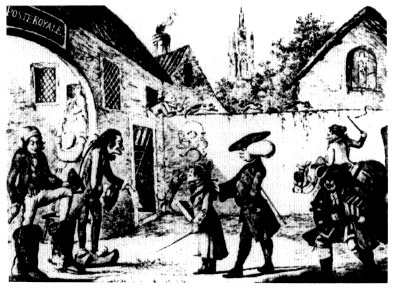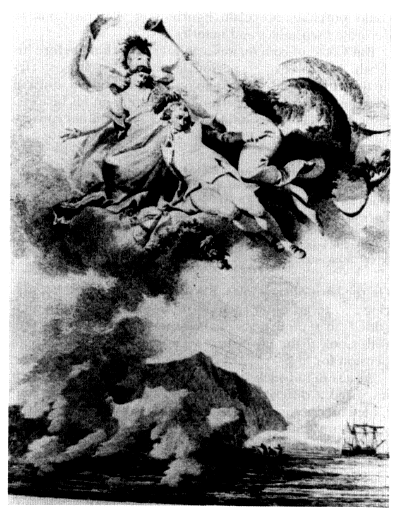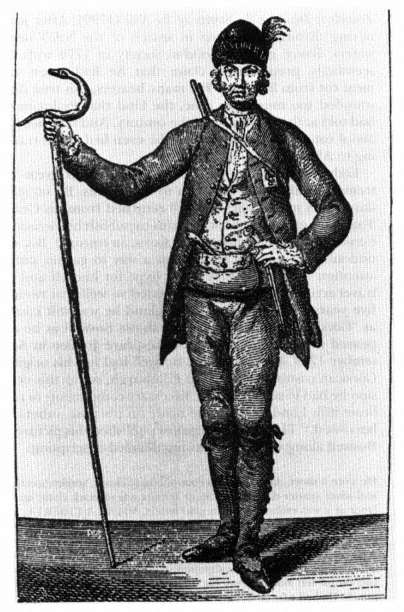The Traveler As Hero
The eighteenth century was by all accounts the age of travel, and the traveler tended to be one of the century's cultural heroes. Travel often served as a rite of passage for the Englishman. Throughout the century, completion of the Grand Tour gave him credentials as a man of learning and cultural polish. And toward the end of the century, completion of the Petit Tour—that is, travels in England and sometimes in Scotland and Wales—increasingly gave him credentials as a man of taste and sensitivity for nature. Chevalier Dennis de Coetlogon seems not to have indulged in hyperbole when he claimedn 1795 that "the English Nation is more inclined to Travelling than any other in Europe ."[8] The English "Milord" of the eighteenth century was as ubiquitous as today's Middle Eastern sheik or Japanese businessman, and most foreigners seemed to think that he carried almost as much money with him.
Figure 4.1.
William Bunbury: Tour to Foreign Parts (1778). (Figures 4.1-4.4
reproduced courtesy of the University Research Library,
University of California, Los Angeles.)
The century's satirists could scarcely have made such fun of travelers if traveling had not been so popular and had not served such an important cultural function. William Bunbury's Tour to Foreign Parts shows a young Englishman on his Grand Tour in France (see Figure 4.1).[9] The tutor (or rather the "bear-leader," as wags liked to call him) stands behind him. The proprietor of La Grenouille Traiteur—or "The Inn of the Treacherous Frog"—stands in front of him, bill of fare extended. One wonders if chicken or cat will grace the young gentleman's dinner table. In any event, his vacant smile gives us no doubt concerning the amount of learning and cultural polish he will acquire on his Grand Tour. In a similar satiric vein, Thomas Rowlandson's Dr. Syntax Copying the Wit of the Window shows an Englishman gathering supposedly valuable information while on his Petit Tour.[10] This information involves
romantic verses, like the following ones, scratched on the windows of inns:
I hither came down
From fair London town
With Lucy so mild and so kind;
But Lucy grew cool,
And call'd me a fool,
So I started and left her behind.
But the eighteenth-century Englishman's itch for travel extended far beyond the confines of the Grand or Petit Tour. The amateur Went to France or rural England; the professional went to the Cape of Good Hope or Java. He might be a seaman, a merchant, a missionary, or—especially toward the end of the century—a naturalist. These travelers to far-off regions tended to suffer less severe treatment from satirists. Their tales might certainly be doubted, but they were more often lionized by polite society.
A brief look at Captain Cook shows the extent to which a traveler could become a cultural hero—imbued with personality traits and heroic actions far transcending anything described on the pages of his journals. To be certain, Cook had the good sense to be murdered by a South Sea islander: dead men make better myths than live ones. Cook's death elevated him to the heights of national hero, and there was no need to remind oneself of the petty reasons for Cook's argument with the natives. But better yet, Cook's subsequent apotheosis elevated him to the status of a secular god. Figure 4.2 is based on a backdrop De Loutherbourg constructed for The Death of Captain Cook; A Grand Serious-Pantomimic-Ballet . . . As Performed at the Theatre-Royal, Covent Garden (1789).[11] In this popular pantomime, Cook's death results from a love triangle among the natives in which he tries to operate as a kind of divine mediator. And to move from the sublime to the mundane, by the beginning of the nineteenth century Englishmen
Figure 4.2.
De Loutherbourg: The Apotheosis of Captain Cook (broadside, 1794).
could purchase porcelain figurines of Captain Cook to decorate their tables and mantles.
But Cook, of course, was a cultural hero long before his death. The force of his personality and the exciting stories he told in person (rather than on the pages of his journal) were enough to make a strong impression on his hearers. James Boswell, for example, reports Cook's dinner conversation in the following fashion:
He gave me a distinct account of a New Zealander eating human flesh in his presence and in that of many more aboard, so that the fact of cannibals is now certainly known. We talked of having some men of inquiry left for three years at each of the islands of Otaheite, New Zealand, and Nova Caledonia, so as to learn the language and . . . bring home a full account of all that can be known of people in a state so different from ours.
On the basis of such tales, Boswell confesses he "felt a stirring . . . to go upon such an undertaking." But he then added, in typical Boswellian fashion, that he would sail with Cook if the government granted him "a handsome pension for life."[12]
As a result of such "public appearances," travelers often imparted a different kind of information than was contained on the pages of the accounts they published. Thus it was not uncommon during the eighteenth century to read between the lines, filling in facts supplied elsewhere by the traveler at some dinner party or by common rumor. John, Durant Breval earned a place among Alexander Pope's dunces for telling stories of how he had helped a nun escape from a convent in Milan, where she was confined against her will. But no such story appears in Breval's Remarks on Several Parts of Europe (1726, 1738). While a tale like that would increase a traveler's fame at dinner parties and in coffee houses, it would scarcely serve as a decorous or relevant topic to be treated in a published travel account. In a similar vein, James Bruce got himself into serious trouble by telling anecdotes prior to publishing his
Travels to Discover the Source of the Nile (1790). After journeying through Abyssinia in search of the Nile's headwaters, Bruce greeted London society in 1774 with the seemingly preposterous claim that he had eaten raw meat cut from live cows. For many hearers, this true story sounded too much like a lie, the kind that Psalmanazar had told at the beginning of the century. And if Bruce lied about eating raw flesh, perhaps he even lied about traveling to Abyssinia.
Eighteenth-century travelers often went to great extremes to call public attention to themselves. By no standard a shy man, James Boswell returned from his Grand Tour with many stories, with plans to publish his Account of Corsica (1768), and with a flashy Corsican costume. Boswell undoubtedly saw this costume as a way to garner public attention—a kind of advertising hype for himself and his travel account. Indeed, he succeeded so well that twenty-five years after his return to England he was still known as "Corsica Boswell." Figure 4.3 shows Boswell as he appeared at Garrick's famous Shakespeare Jubilee in September 1769. Unfortunately, Boswell had left his original Corsican costume at home in Edinburgh, so for this occasion he had to search out the necessary components to replicate it in London. Some he made on purpose, others he borrowed.[13] The London Magazine published this picture of Boswell along with the following detailed description:
He wore a short, dark-coloured coat of coarse cloath, scarlet breeches, and white spatter-dashes, his cap or bonnet was of black cloth; on the front of it was embroidered, in gold letters, VIVA LA LIBERTA; and on one side of it was a handsome blue feather and cockade, so that it had an elegant, as well as a warlike appearance. On the breast of his coat was sewed a Moor's head, the crest of Corsica surrounded with branches of laurel. He had also a cartridge-pouch, into which was stuck a stiletto, and on his left side a pistol was hung from the belt of his cartridge-pouch. He had a fusee slung across his shoulder, wore no powder in his hair, but had it platted, at its full length, with a knot of blue ribbon at the end of it. He had by way of a staff a very curious vine. . . He wore no mask, saying it was not proper for a gallant Corsican.[14]
Figure 4.3.
James Boswell in the London Magazine (Sept. 1769), p. 455.
Chances are that Boswell wrote this detailed description specifically for inclusion in the London Magazine .
When Pierre Maupertuis returned from his expedition to Lapland in 1736, he brought back his heavy fur clothing but one-upped Boswell by also bringing back two Lapp girls. Maupertuis's Figure of the Earth (1738) never mentions these girls.[15] After all, they had nothing to do with the goal of his expedition, which was to measure the length of a degree along the meridian in an attempt to determine whether Newton had been correct in claiming the earth was flattened at the poles. Indeed, Maupertuis refuses even to describe his shipwreck on the way home because it does not "belong to the present Subject" of his book.[16] Maupertuis undoubtedly had many reasons for transporting these girls to Paris. They were curiosities, much like the inscriptions and antiquarian artifacts brought back by travelers to Italy and much like the plants and insects brought back by travelers to the New World. But they also helped make Maupertuis famous. He might be a rather anonymous person in his travel account, but he had no intention of remaining anonymous in the salons of Paris. Voltaire originally celebrated Maupertuis and his fellow voyagers by saying:
Heroes of science, hail! like Argonauts ye brave
The dangers of far climes, the perils of the wave;
Your measurements exact and arduous give birth
To the true knowledge of the figure of the earth.[17]
In a subsequent edition of this poem, Voltaire changed his tune by trivializing Maupertuis's achievements: a "measurement, Lapp girls, and other curious things."[18]
And, finally, when Dampier brought back Prince Giolo (or Prince Jeoly) from his first voyage, his main purpose seems to have been merely financial: he would earn money displaying this tattooed South Sea islander much as Glumdalclitch's father made money showing Gulliver in Brobdingnag. Dampier's descriptions of Giolo in A New Voyage
are straightforward, matter-of-fact, and unromantic. By contrast, the Londoners to whom Dampier sold Giolo came up with advertising copy that could serve as the basis of an exciting romance. A broadside owned by the Clark Library claims that Prince Giolo was shipwrecked in a violent tempest, taken prisoner on the coast of Mindanao, and then sold to foreigners bound for Europe. It tells us that except for face, hands, and feet, Giolo's entire body is painted. On his back parts, for example, could be seen "a lively representation of one quarter part of the World" with "the Artick and Tropic Circles center[ed] in the North Pole of his Neck." Why go to the expense of sending mariners to chart the Pacific when it had already been done for us on Giolo's back? This broadside also tells us that the painting on Giolo's body made him invulnerable to "all sorts of the most venomous, pernicious Creatures [that] can be found; such as Snakes, Scorpions, Vipers, and Centapees."[19]
This is the stuff romances are made of. But Dampier's New Voyage —like most eighteenth-century travel accounts —is not the stuff romances are made of unless one reads between the lines. And to read between the lines requires the reader's imaginative involvement—an involvement that glorifies the traveler and, I think, projects the reader into the traveler's situation.


